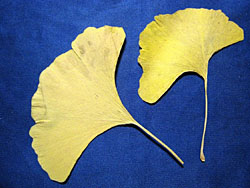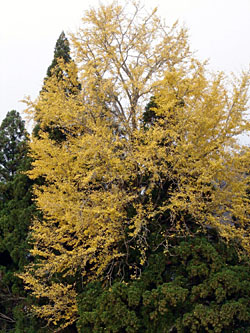The leave of the ginkgo is unusual in that each blade has multiple midribs fanning out rather than a single central one.
Seasonal waves of gold
By Mark Brazil | Jan 17, 2007
GINKGO TREESI am fresh back from an exciting wildlife watching adventure in the national parks of Madhya Pradesh and Assam, India (more of that in a subsequent column). Thanks to the latest Internet and satellite software, I can zoom in to view the very area in Assam that I visited last week on the southern bank of the mighty Brahmaputra River in Kaziranga National Park.
Such technology provides a view of the world almost unimaginable even just 10 years ago. Then, I relied entirely on my trusty Times World Atlas and my imagination. But the swift pace of change has only left me impatient for more. Not content with static satellite images of places that I have been — some of those images several years out of date — what I want now is live satellite feed, so that on any given day I can zoom in and watch “live” how the season is progressing.
Japan would be a marvelous place to have that currently unavailable opportunity; by virtue of its topography, the great spread of the country from north to south, and the altitudinal range from sealevel to mountain ranges reaching more than 3,000 meters, seasonal change washes up and down the archipelago like an inexorable slow-moving wave.
If we could watch as the patterns of seasonal color shifted before our very eyes, we’d see the dark green hues fading steadily and shifting from the north to the south. The forests of the north would fade to oranges, reds and yellows, and as those colors flowed southwards, a dusting of white would brush across the central highlands of Hokkaido, then flow southwards in pursuit of the draining color.
In the south, patches of deep green would remain, giving contrast first to other patches of color, then to the grayness of leafless trees. In spring, waves of white, then pinkish blossoms would flicker and spread northwards like a running bush fire as the magnolias, plums and then cherries burst into bloom; following swiftly behind would be a wave of the freshest of delicate green, followed by another of deepening, darkening green. It would be like watching a living tapestry shift and change before your eyes.
A little over a month ago, in the early days of December, I encountered a wave of color in the mountains of central Honshu that I miss in Hokkaido: the delightful, dreamy gold of ginkgo (icho) leaves. By now, that particularly beautiful wave must be reaching its southern limits, perhaps even petering out toward the southwestern region of Honshu.
I find something inspiring in the bright yellow and pale gold of the ginkgo’s leaves. It is as if a summer’s worth of sunshine has been collected, concentrated and at last returned, bringing not only color but also depression-lifting brightness to gloomy early winter days.
A mature ginkgo, reaching to 20 or even 35 meters in height is a distinctive tree with a broad crown, widespread branches and curiously shaped leaves. Its history is also worthy of admiration — only a single species survives in a wholly unique family, the ginkgoaceae. A member of the gymnosperms, or “naked seed” plants, the ginkgo is sometimes called a “living fossil.” This relic of ancient times can be seen as symbolic of changelessness, surviving through an unimaginably long past.
As the fan-shaped leaves fall, they twist and spin, ultimately carpeting the ground in drifts of fine-ribbed shapes. Such golden cascades have been taking place each autumn and winter since before dinosaurs roamed the earth, and we are incredibly fortunate to be able to bear witness to the very last species of the ginkgos.
Perhaps you watched that wave of inspiring color wash over your hometown. Perhaps you live in Tokyo, in which case you can hardly avoid the official symbol of the capital — there the leaf’s shape is to be found almost everywhere, from roadside railings to official pamphlets, and the trees line many of the city’s streets. Though, as a symbol of changelessness, I wonder how it came to be chosen as the emblem for a city that has reshaped and reinvented itself over and over again.
Perhaps you enjoy the delicious ginkgo nuts (ginnan), which are served grilled on skewers and are commonly added to savory egg-custard (chawan-mushi).
Otherwise known as the Maidenhair Tree, the ginkgo’s ancestors were first recognized in fossil form, their leaves found in deposits dating back some 270 million years to the Permian Period. The Western world was ignorant of the existence of living ginkgos until the German physician and botanist Engelbert Kaempfer (1651-1716), who lived in Japan from 1690 to 1692, discovered it here, where it had been grown from seeds imported from China around 1192 AD.
In China, this last remnant of a once great lineage of early seed plants had survived at the hands of Buddhist monks who cultivated it in monastic, palace and temple gardens. Kaempfer carried seeds back with him to Europe and trees planted in the early 1700s can still be found growing there. It has subsequently been introduced as an urban street plant in many parts of the world, making it a surprisingly familiar tree to urbanites worldwide.
Herbalists know it as an important natural ingredient in medicines to boost energy and stamina and to sharpen the mind, and it is apparently used professionally in the early stages of treating dementia, particularly Alzheimer’s disease, to such an extent that it is the most widely sold plant-medicine in Europe and one of the 10 top-selling herbal medications in the United States.
In our goal-oriented capitalist world, practical value and usefulness are respected attributes. In this sense, we can admire the ginkgo for its medicinal value, its food value, for being remarkably pest-and-disease free, and for being astonishingly tolerant of harsh conditions, including pollution, making it ideally suited for urban planting.
Yet, there is more than value here, there is a stunningly beautiful tree. Perhaps your local trees are still golden yellow, perhaps their leaves have fallen and been scattered on winter winds. If you find one, take a moment to admire the extraordinary number of finely parallel veins running across the fan-shaped leaf. Soon the trees will be fresh-leaved and pale green again — further beauty to be cherished not for their value but merely for being there. And one day, if the technology arrives, perhaps we will be able to watch in real time and admire as that golden wave sweeps down the country, followed by the northward sweep of pale green.


